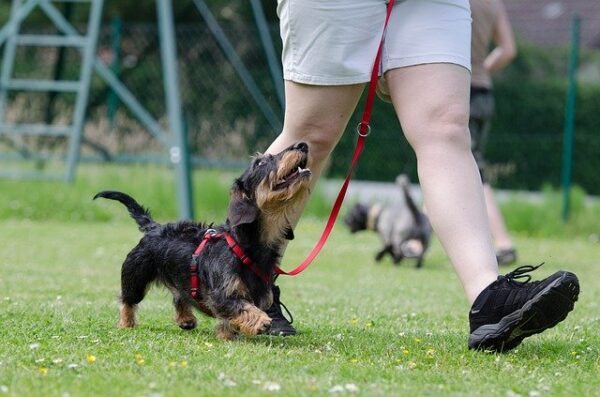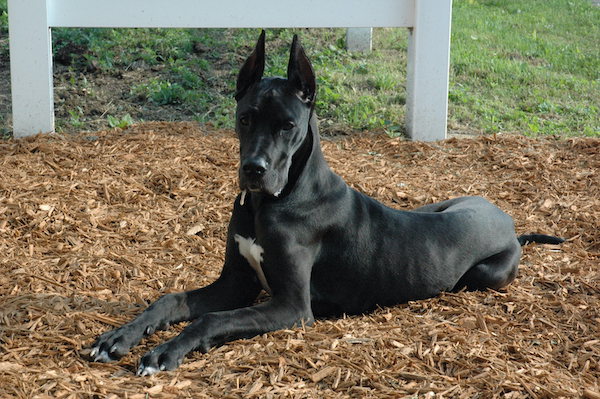
Dog owners know that training their new pup can be one of the most rewarding, and one of the most frustrating things, they will ever experience. From sit and stay to roll over and even play dead, it can be quite difficult to train these behaviors into your dog, and even more difficult to train out bad behaviors that they’ve already picked up. But if you’re a novice dog trainer, where should you start? And, perhaps more importantly, what are the best techniques to use?
Classic Conditioning Dog Training
If you’re a fan of physiology and psychology, you’ve surely heard of Pavlov’s classical conditioning experiments. In this experiment, Ivan Pavlov would ring a bell before giving his dogs a treat. Initially, the treat caused the dogs to salivate but before long, the dogs would salivate whenever the bell was rung, even when a treat wasn’t being given. Pavlov called this process classical conditioning, and it can be used to train dogs very effectively.
Generally speaking, classical conditioning is learning by association. One of the most common ways to do this in dogs is through the use of a clicker, otherwise known as clicker training. The clicker is used in association with a treat; the clicker is pressed and a treat is offered whenever the dog follows a command. The dog then begins to associate the sound of the clicker with their positive, tasty reward, and will eventually learn the command without the need for treats or the clicker.
Classical conditioning can also be used to help pets accept things that they might not initially like. If your dog doesn’t do well in a crate, it can be trained to love its crate using classical conditioning. Try to associate positive, pleasant things (such as treats) with the crate. For example, every time you open the door to the crate, give your dog a treat, and then bring your dog near the crate and give him more treats. Finally, entice your dog to enter the crate with even more treats. Eventually, your dog will associate the crate with treats, and he or she will no longer harbor any hatred toward it.
This type of dog training does come with both positives and negatives. Here is a list of the pros and cons of classical conditioning:
Pros:
- The atmosphere created is positive and highly rewarding
- Not only helps with training but can help pets accept things they at first do not like
- Can be used in association with many different markers, including whistling or vocal praise
Cons:
- Some dogs do not respond well to the clicker
- Requires high reward drive in the dog being trained
- Behaviors learned through classical conditioning are more prone to abandonment
Operant Conditioning Dog Training
This type of dog training is the most widely used; if you google “how to train a dog”, this will be the number one result. Operant conditioning is based on controlling the environment so that favorable behavior results in positive consequences and unfavorable behavior results in negative consequences.
For example, when your dog sits the first time you ask them to, you can reward them with a treat or vocal praise. On the other hand, if your dog jumps up on you, turning away and ignoring him can be a powerful negative consequence.

Interestingly enough, operant conditioning has been used to teach three different dogs how to drive a car in New Zealand, so it should work pretty well when teaching your dog how to sit and stay.
What’s important to note about operant conditioning is the positive and negative values associated with the training. Positive and negative don’t necessarily relate to the type of stimulus being used; rather, positive refers to the addition of stimulus, and negative refers to the removal. Negative reinforcement, then, is not striking a dog for bad behavior but ignoring the dog until the behavior ceases, and then rewarded the dog upon completion of the good behavior.
Like all other forms of training, operant conditioning has pros and cons, and will work better for some pets than others.
Pros:
- Instills trusting bond between dog and trainer
- Encourages growth of confidence in dogs, accounting for higher self-esteem when meeting new people or going new places
- Does NOT use physical force or angry shouting
Cons:
- Risks your pet only performing desired commands when tempted with positive reinforcement/treats
- Confusion can be elicited from lack of clear verbal instruction or hand signals
Traditional Dog Training
This type of training is named as such because it pre-dates any science-based evidence in what does and does not work when training a dog. That being said, many people still believe this is how to train a dog best, and although it does seem a tad barbaric, many people have seen this type of training work with their dogs. It is important to note that this theory of training comes from dominance and wolf pack theory, which have both been proven ineffective by modern science.
The principles of traditional dog training are rather simple; it makes use of punishment and physical coercion to force a dog into the desired behavior. In theory, the dog is behaving badly because they are attempting to assume a position of dominance against the owner. Therefore, the owner must assert his or her dominance over the dog in order to make them obey commands.
Typical punishment for bad behavior can include pinches, grabs, and snaps of the leash, which are paired with positive reinforcement when the appropriate behavior is given. Some trainers also opt to use tools like shock collars, which can be used to deliver a small shock to a dog when it exhibits an inappropriate behavior, such as barking at the mailman as he passes by.
As stated previously, all theories of dog training have both positive and negative aspects, and although this one does seem to have an excess of negatives, it has been proven to work with some dogs.
Pros:
- Proven technique that can effectively train out bad behaviors
- Positive reinforcement is still used when the desired behavior is performed
Cons:
- Can lead to a fearful dog who is harder to train, or even make a dog more aggressive, especially with significant physical punishment
- The more punishment used in training, the more anxious a dog can become
- This training technique seems more capable of training out bad behaviors, rather than training your dog to perform certain tasks or tricks
Model-Rival or Mirror Dog Training
 Model-rival training is less popular than the others mentioned above, but it has been proven to allow dogs to mimic behavior by learning from a model or rival.
Model-rival training is less popular than the others mentioned above, but it has been proven to allow dogs to mimic behavior by learning from a model or rival.
Using this theory, the trainer can have another human acting as the model, praising them for certain positive activities, and scolding them for negative behaviors. While this is happening, the dog is observing what happens, learning which certain behaviors elicit rewards, and which result in punishment.
Instead of acting as a model, the human can also act as a rival. The human and the dog will compete to do the right tasks, which drives the dog to complete the task more quickly so that they can earn the reward over the human.
Mirror training works almost exactly the same way, except instead of using an extra-human, the dog models their behavior based on the trainer themself. In this theory, the dog simply learns by example.
This type of dog training is great because it can also be done using another dog. If a trainer has another pet that is fully trained, or even has a companion whose dog is fully trained, they can use that dog to teach their own positive behaviors. In this scenario, the trained dog is offered a reward for good behavior, which prompts the untrained dog to do the same, hoping for the same reward.
Pros:
- Does not require the use of punishment, including yelling or physical punishment
- Has a similar level of success as operant conditioning
- Many owners find this type of training “more natural” and “preferable”
Cons:
- Requires dog to be attentive enough to pick up on the positive behavior that elicited the reward
Therefore, if you have a dog who is a bit of a scatterbrain, and has trouble focusing, model-rival and mirror training might not be the best fit!
Science-Based Dog Training
This theory of how to train a dog has received a lot of buzz lately but is hard to define because of its wide breadth and fluidity. In science-based dog training, a deep understanding of a dog’s nature and behavior, and combines tools like classical conditioning and positive and negative reinforcement.
A science-based trainer will have an in-depth understanding of traditional methods, dominance theory, and wolf pack theory, all while knowing that these theories have been proven ineffective and that physical punishment is counterproductive when training a dog. Instead, science-based trainers train their dogs in the most humane way possible.
For example, before trying to teach a desired behavior to their dog, a science-based trainer will take into consideration his or her surroundings, their dog’s history, and their current temperament.
Since science-based training is still being developed and is under constant evolution, it’s sort of hard to pin down. If you’re interested in training your dog this way, your best bet is to consult an expert. Still, there are some defined pros and cons of science-based training.
Pros:
- Uses a wide variety of methods so it is effective for many dogs
- Generally does not include punishment
Cons:
- Usually requires a more experienced dog trainer, and someone who has a complete grasp on science-based training
- May require a significant amount of research on the trainer’s part
Relationship-Based Dog Training
Much like science-based training, relationship-based training combines several different training methodologies into one. Most important, though, is the relationship between the trainer and the dog they are training.
In relationship-based dog training, communication between the trainer and the dog is fostered, and their bond is strengthened so that the dog always knows what their trainer wants from them. The trainer, then, must learn how to read their dog’s body language and come to an understanding of what most motivates their dog. It is also important that a dog’s basic needs are met before training sessions can occur.

For relationship-based training to work properly, the environment around the dog must be controlled. For example, when teaching a dog to sit, the training should occur in a quiet room with no distractions before being attempted in a loud and noisy environment where the dog might be tempted not to listen. The difficulty of the setting can be gradually increased until the trainer is convinced that the dog is able to repeat the desired command with 100% accuracy.
What’s interesting about relationship-based training is that there are no negative consequences or punishments when a desired behavior isn’t performed. If the dog isn’t performing the way the trainer likes, it’s up to the trainer to figure out why. Is the dog distracted, or are they hungry? Is this environment too noisy, or perhaps are they too tired right now to continue training? This added responsibility on the trainer shifts blame away from the dog and keeps the trainer responsible for solving their dog’s problem behaviors.
Pros:
- No negative reinforcement or punishment required
- A positive and meaningful relationship between trainer and dog is fostered
- It is inclusive of many different training theories, so it is effective for many dogs
Cons:
The only con for this type of training is the amount of time and effort that is required. Relationship-based training is generally regarded as a more intense form of training and requires an immense amount of time, patience, and effort in order to make it work. But if you can, you will very likely see the relationship between you and your dog, and your pet’s ability to perform trained commands, flourish.
Conclusion
As you can see, there is no one answer to the query: how to train a dog. Instead, there is a multitude of options, and while some may work better than others, it’s truly up to the trainer to choose an option that will work for their dog. And, as we saw in science-based and relationship-based training, sometimes combining theories and trying new techniques is the best thing a trainer can do. You never know what training tools a dog will respond best to until you try.
Most importantly, remain patient and compassionate toward your pet; they are certainly doing their best, and with enough time and effort, you will see results.




